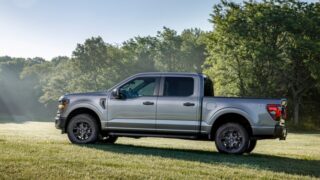TESTED: Is the 2024 F-150 PowerBoost Hybrid As Efficient as Ford Says?

The 2024 F-150 PowerBoost claims to offer up to 22 mpg on the highway and 24 mpg in the city. Real-world results are more complicated.
Full disclosure Ford provided transportation and accommodations for Ford Truck Enthusiasts to attend a two-day press event where we drove the F-150 PowerBoost, F-150 Tremor, and F-150 Raptor R. Ford then provided a 2024 F-150 XLT loan for further testing.
FoMoCo currently offers four F-150 engine options here in 2024. The 2.7L EcoBoost V6, 5.0L Coyote V8, 3.5L EcoBoost V6, and the 3.5L PowerBoost V6. The F-150 PowerBoost, not to be confused with Ford’s diesel PowerStroke, is Ford’s trademarked name for gasoline hybrid. It starts with the already potent 3.5L EcoBoost, a twin-turbocharged, direct injection V6 engine making 400 peak horsepower and 500 ft.-lbs. of peak torque. Ford then adds a 35-kilowatt electric motor into the 10-speed automatic transmission’s bellhousing. (It takes up the same location as the torque converter on a conventional automatic transmission.)
At 430 horsepower and 570 ft.-lbs of torque, the PowerBoost is the most powerful 2024 F-150 engine option for models not named Raptor or Lightning. It is an optional engine on XL (fleet sales only), XLT, Lariat, King Ranch, and Platinum. It is standard on Platinum Plus, and not available on STX, Tremor, or Raptor. Despite the extra power, the hybrid system’s added weight lowers max towing and payload compared to the standard 3.5L EcoBoost. (11,200 lbs. towing vs 13,500 lbs and 1,755 lbs. payload vs 2,445 lbs.)

It’s worth noting that transmission-integrated hybrid systems are becoming more common in trucks and SUVs. (Toyota offers a similar hybrid system in the current generation Tacoma, Tundra, Sequoia, and Land Cruiser.) Other key components include high-voltage wiring, a 1.5 kWh lithium-ion battery, regenerative braking, and standard Pro-Power On Board.
Speaking of which, 2.4 kW Pro Power On Board, which can run a campsite at full capacity for 85 hours on one tank of gas, is standard on XL fleet models, XLT, and Lariat. 7.2 kW Pro Power On Board, which can power a job site at full capacity running stuff like welders for 32 hours at full capacity, is standard on King Ranch, Platinum, and Platinum Plus. On XLT and Lariat, it’s a $750 option.
What’s New for 2024?

The 3.5L PowerBoost drivetrain debuted in the 2021 model year when we declared it the best F-150 engine of the year. For 2024, much of the system remains the same, save for two key differences. First, Ford’s engineers deleted the belt-driven starter. This starter fires the gas motor when transitioning from all-electric driving, or when auto start/stop engages. Instead, the 2024 PowerBoost now utilizes the electric motor itself along with the traditional flex-plate mounted starter. Ford said the engineers wanted to reduce complexity and costs while pursuing added refinement and smoothness.
Second, the PowerBoost is no longer available on 2WD F-150s or XL (outside fleet sales).
How Much Does It Cost?

The 3.5L PowerBoost was, in previous model years, the most expensive engine option. Effectively a $2,000-$5,000 upgrade depending on the trim level. For 2024, with Ford hoping to double PowerBoost’s sales from 10% to 20% of total volume, the PowerBoost is technically a no-cost option compared to the 3.5L EcoBoost with a couple of caveats.
Since the PowerBoost is only available in 4WD configurations, it technically costs an extra $3,860 to add the PowerBoost when starting with a 2WD XLT. That said, if 4WD is already selected, the PowerBoost costs the same as the EcoBoost… Unless one orders a low-option Lariat. In this trim, the PowerBoost can be ordered for $785 less than the 3.5L EcoBoost. Why? Because the EcoBoost engine option requires adding in the Tow/Haul Package, and the PowerBoost does not.
F-150 PowerBoost Fuel Economy Results

According to FuelEconomy.gov, the 2024 F-150 3.5L PowerBoost should achieve 22 mpg city, 24 mpg city, and 23 mpg combined. The F-150’s other three powertrains can match or beat the PowerBoost on the highway (24-25 mpg). However, the PowerBoost is roughly 3-4 mpg more efficient combined and 3-8 mpg more efficient in the city.
In our time driving and testing the PowerBoost, the F-150’s computer estimated the following fuel economy results with 1-3 passengers and no trailer attached —
- Our first experiment netted 17.6 mpg over 1 hour, 49 minutes, and 54 seconds. It was 98 degrees under a glaring sun in Palm Springs, California. We drove 63.6 miles, 7.6 of which were all-electric, mostly at 70-80 mph in heavy winds, and with a few wide-open-throttle acceleration runs (for science!). The truck spent roughly 50% of the time sitting and running for photography and other testing. Because of the extreme heat and A/C set to max cool, the vehicle’s gas motor ran a significant portion of that time.
- Next, we netted 23.7 mpg driving 115.4 miles from Palm Springs to Los Angeles over the course of 2 hours, 26 minutes, and 45 seconds. The truck managed 19.7 all-electric miles. Most of the time was spent at 55-70 mph and some moderate stop-and-go traffic. Temperatures were in the mid-60s to mid-70s.
- Around Los Angeles, the truck managed 11.8 mpg driving 1.5 miles between two stores over 7 minutes and 27 seconds (with 0.7 all-electric miles driven). The temps were relatively cool, but most of the trip was uphill and the gas engine was cold. On the return trip, which is flat and/or downhill, it managed 21.6 mpg over 3.3 miles (1.7 of those all-electric) in 14 minutes and 32 seconds.
- However, on a different day during a nearly identical trip to the return above, it earned 24.5 mpg over those same 3.3 miles (2.1 all-electric) over 11 minutes and 8 seconds. The truck hit fewer red lights.
- Lastly, the PowerBoost managed 9.9 mpg on the day I drove my daughter to a dance class and back. Over the course of 1 hour, 24 minutes, and 19 seconds, I drove 6.1 miles, 3.2 of which were all-electric, and sat in the truck for one hour with everything on. During this hour, the gasoline motor kicked on approximately four times and ran for a few minutes each time. (For context, each way to the dance studio, over 2.9 miles, the PowerBoost managed 15.2 mpg with 1.6 miles of all-electric driving.)
- As I write this, the truck claims to have earned 19.9 mpg combined over 7 hours, 8 minutes, and 49 seconds. Mileage totaled 182.0 miles, 38.9 of which were all electric.

As you can see, the F-150 PowerBoost delivers a broad range of results based on numerous variables. These include environmental conditions, power needs, driver inputs, traffic density, and road conditions. Drive the PowerBoost hard and it guzzles gasoline like a Mustang running around a race track. But when it can cruise — long, flat suburban roads with fewer red lights or open highways — the hybrid system delivers impressive results.
It is, without a doubt, the most efficient full-sized truck Ford makes this side of the 6.7L PowerStroke diesel.
That said, and maybe it’s just Southern California geography, or the traffic light engineering of the region’s suburban sprawl, but I found it mostly impossible to hit 24 mpg city, which dragged down the combined rating as well. It’s still impressive compared to the non-hybrid options, but don’t mistake the PowerBoost for a Prius.
A Few PowerBoost Tips & Notes

During our time with the F-150 PowerBoost, we noticed a few things owners may find helpful in trying to understand and/or boost fuel economy results with this hybrid system —
- The PowerBoost is least efficient when it’s first started. It has a long startup sequence where the RPMs surge for a good minute (presumably to help warm the gas motor and catalytic converters up to operating temperature to help emissions).
- Almost any amount of acceleration kicks on the gasoline motor. Basically, if you need torque, the gas motor runs.
- It’s reasonably efficient on the highway, but aerodynamics are a limiting factor. Keep it below 70 for optimum efficiency and avoid headwinds if possible.
- HVAC settings (A/C in the summer, heat in the winter) cause the gasoline motor to run more.
- Once the truck is warmed up, it uses the gasoline motor less.
- On flat surfaces or downhill, you can drive upwards of 45 mph in all-electric mode. It mostly kicks in when coasting or lighting braking to a stop, but will also cruise with very light throttle input.
- Literal stop-and-go traffic, or lots of red lights, hurts efficiency
- Moderate traffic where you can keep some momentum, and on occasions where I made more green lights, it’s really efficient. This truck loves running at 15-50 mph.
What’s it Like to Drive the PowerBoost?

Unlike more traditional hybrid systems — think Ford Maverick or Toyota Prius — trucks with transmission-integrated hybrid systems appeared designed for both performance and efficiency. 570 ft-lbs of max torque hits hard off the line, rocketing the F-150 PowerBoost from redlight to redlight with enough juice to smoke the tires if desired. But mostly it’s just like driving a normal truck until you look down and realize the motor turned off when you were coasting to a stop or cruising in traffic.
Twin-turbo V6s aren’t, themselves smooth engines. But PowerBoost’s transitions between gas power and all-electric driving are exceptionally smooth. Restarting from a standstill is more noticeable. And the 3.5L sixer remains buzzy and there’s torque lag at times. But there’s minimal delay on the restart and a little break-torquing removes lag if you want a thrilling launch. The 10R80 transmission also does a hell of a job keeping the PowerBoost where it needs to be — for both performance and economy.
In short, the PowerBoost drives like a normal F-150, smooth and powerful, with room for four full-sized adults. There are a couple of quirks in the hybrid experience, but as a no-cost upgrade (or as a cheaper option on a low-option Lariat), it’s hard to beat the PowerBoost for the way it mixes power, performance, and on-board generator, and added efficiency.
Even if they aren’t always as efficient as the window sticker claims.
Image Credit: Michael S. Palmer




